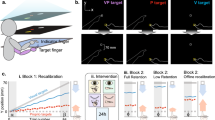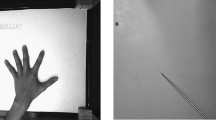Abstract
When vision and proprioception are rendered incongruent during a hand localisation task, vision is initially weighted more than proprioception in determining location, and proprioception gains more weighting over time. However, it is not known whether, under these incongruency conditions, particular areas of space are also weighted more heavily than others, nor whether explicit knowledge of the sensory incongruence (i.e. disconfirming the perceived location of the hand) modulates the effect. Here, we hypothesised that both non-informative inputs coming from one side of space and explicit knowledge of sensory incongruence would modulate perceived location of the limb. Specifically, we expected spatial weighting to shift hand localisation towards the weighted area of space, and we expected greater weighting of proprioceptive input once perceived location was demonstrated to be inaccurate. We manipulated spatial weighting using an established auditory cueing paradigm (Experiment 1, n = 18) and sensory incongruence using the ‘disappearing hand trick’ (Experiment 2, n = 9). Our first hypothesis was not supported—spatial weighting did not modulate hand localisation. Our second hypothesis was only partially supported—disconfirmation of hand position did lead to more accurate localisations, even if participants were still unaware of their hand position. This raised the possibility that rather than disconfirmation, a simple movement of the hand in view could update the sensory–motor system, by immediately increasing the weighting of proprioceptive input relative to visual input. This third hypothesis was then confirmed (Experiment 3, n = 9). These results suggest that hand localisation is robust in the face of differential weighting of space, but open to modulation in a modality-specific manner, when one sense (vision) is rendered inaccurate.




Similar content being viewed by others
References
Bellan V, Gilpin HR, Stanton TR, Newport R, Gallace A, Moseley GL (2015) Untangling visual and proprioceptive contributions to hand localisation over time. Exp Brain Res 233:1689–1701. doi:10.1007/s00221-015-4242-8
Bernstein IH, Edelstein BA (1971) Effects of some variations in auditory input upon visual choice reaction time. J Exp Psychol 87:241–247
Bernstein IH, Clark MH, Edelstein BA (1969) Effects of an auditory signal on visual reaction time. J Exp Psychol 80:567–569
Dijkerman HC, de Haan EH (2007) Somatosensory processes subserving perception and action. Behav Brain Sci 30:189–201. doi:10.1017/S0140525X07001392 (discussion 201–139)
Ehrsson HH, Kito T, Sadato N, Passingham RE, Naito E (2005) Neural substrate of body size: illusory feeling of shrinking of the waist. PLoS Biol 3:2200%@ 1544-9173
Ernst MO, Bulthoff HH (2004) Merging the senses into a robust percept. Trends in Cognit Sci 8:162–169. doi:10.1016/j.tics.2004.02.002
Gruters KG, Groh JM (2012) Sounds and beyond: multisensory and other non-auditory signals in the inferior colliculus. Front in Neural Circuits 6 doi:10.3389/fncir.2012.00096
Jonides J (1981) Voluntary versus automatic control over the mind’s eye’s movement. In: Baddeley JBLaAD (ed) Attention and Performance IX. Erlbaum, Hillsdale, pp 187–203
Kean M, Crawford TJ (2008) Cueing visual attention to spatial locations with auditory cues. J Eye Mov Res 2:1–13
Lackner JR (1988) Some proprioceptive influences on the perceptual representation of body shape and orientation. Brain: A J Neurol 111(Pt 2):281–297
Longo MR, Kammers MP, Gomi H, Tsakiris M, Haggard P (2009) Contraction of body representation induced by proprioceptive conflict. Curr Biol: CB 19:R727–R728. doi:10.1016/j.cub.2009.07.024
Moseley GL, Brugger P (2009) Interdependence of movement and anatomy persists when amputees learn a physiologically impossible movement of their phantom limb. Proc of the Natl Acad of Sci of the USA 106:18798–18802. doi:10.1073/pnas.0907151106
Moseley GL, Gallace A, Spence C (2009) Space-based, but not arm-based, shift in tactile processing in complex regional pain syndrome and its relationship to cooling of the affected limb. Brain: a J Neurol 132:3142–3151. doi:10.1093/brain/awp224
Moseley GL, Gallace A, Iannetti GD (2012a) Spatially defined modulation of skin temperature and hand ownership of both hands in patients with unilateral complex regional pain syndrome. Brain: A J Neurol 135:3676–3686. doi:10.1093/brain/aws297
Moseley GL, Gallace A, Spence C (2012b) Bodily illusions in health and disease: physiological and clinical perspectives and the concept of a cortical ‘body matrix’. Neurosci Biobehav Rev 36:34–46. doi:10.1016/j.neubiorev.2011.03.013
Moseley GL, Gallace A, Di Pietro F, Spence C, Iannetti GD (2013) Limb-specific autonomic dysfunction in complex regional pain syndrome modulated by wearing prism glasses. Pain 154:2463–2468. doi:10.1016/j.pain.2013.07.026
Newport R, Gilpin HR (2011) Multisensory disintegration and the disappearing hand trick. Curr Biol 21:R804–R805. doi:10.1016/j.cub.2011.08.044
Newport R, Preston C, Pearce R, Holton R (2009) Eye rotation does not contribute to shifts in subjective straight ahead: implications for prism adaptation and neglect. Neuropsychologia 47:2008–2012. doi:10.1016/j.neuropsychologia.2009.02.017
Reid E, Harvie D, Miegel R, Spence C, Moseley GL (2015) Spatial summation of pain in humans investigated using transcutaneous electrical stimulation. J pain: Off J the Am Pain Soc 16:11–18. doi:10.1016/j.jpain.2014.10.001
Ro T, Hsu J, Yasar NE, Elmore LC, Beauchamp MS (2009) Sound enhances touch perception. Exp Brain Res 195:135–143. doi:10.1007/s00221-009-1759-8
Simon JR, Craft JL (1970) Effects of an irrelevant auditory stimulus on visual choice reaction time. J Exp Psychol 86:272–274
Spence C (2013) Just how important is spatial coincidence to multisensory integration? Evaluating the spatial rule. Ann of the New York Acad of Sci 1296:31–49. doi:10.1111/nyas.12121
Spence CJ, Driver J (1994) Covert spatial orienting in audition: exogenous and endogenous mechanisms. J Exp Psychol: Human Percept and Perform 20:555
Spence C, McDonald J (2004) The crossmodal consequences of the exogenous spatial orienting of attention. In: Calvert GA, Spence C, Stein BE (eds) The Handbook of Multisensory Processing. MIT Press, Cambridge, pp 3–25
Spence C, McDonald J, Driver J (2004) Exogenous spatial cuing studies of human crossmodal attentiona and multisensory integration. In: Spence C, Driver J (eds) Crossmodal Space and Crossmodal Attention. Oxford University Press, Oxford, pp 277–320
Spence C, Pavani F, Maravita A, Holmes NP (2008) Multi-sensory interactions. In: Lin MC, Otaduy MA (eds) Haptic Rendering: Foundations, Algorythms, and Applications. AK Peters, Wellesley, pp 21–52
Tsay A, Savage G, Allen TJ, Proske U (2014) Limb position sense, proprioceptive drift and muscle thixotropy at the human elbow joint. J Physiol 592:2679–2694. doi:10.1113/jphysiol.2013.269365
Acknowledgments
We wish to thank A Prof Roger Newport from Nottingham University for extensive and very helpful comments on earlier versions of this manuscript.
Funding
G. Lorimer Moseley (ID 1061279) and Tasha R. Stanton (ID 1054041) are supported by National Health & Medical Research Council Research Fellowships and an Italian postgraduate scholarship to Valeria Bellan.
Author contributions
VB, HRG, TRS, AG and GLM conceived and designed the experiments. VB, HRG and LKD collected the data. All authors participated in the analysis and interpretation of the data and in the drafting of the manuscript. All authors approved the final version of the manuscript submitted for publication.
Author information
Authors and Affiliations
Corresponding author
Ethics declarations
Conflict of interest
GLM has received support from Pfizer, Kaiser Permanente, Agile Physiotherapy, Results Physiotherapy, and Workers' Compensation Authorities in Australia, North American and Europe. GLM receives royalties for books on pain and rehabilitation and speaker fees for lectures on pain and rehabilitation.
Ethical approval
All procedures performed in studies involving human participants were in accordance with the ethical standards of the institutional and/or national research committee and with the 1964 Helsinki Declaration and its later amendments or comparable ethical standards.
Electronic supplementary material
Below is the link to the electronic supplementary material.
Rights and permissions
About this article
Cite this article
Bellan, V., Gilpin, H.R., Stanton, T.R. et al. Relative contributions of spatial weighting, explicit knowledge and proprioception to hand localisation during positional ambiguity. Exp Brain Res 235, 447–455 (2017). https://doi.org/10.1007/s00221-016-4782-6
Received:
Accepted:
Published:
Issue Date:
DOI: https://doi.org/10.1007/s00221-016-4782-6




